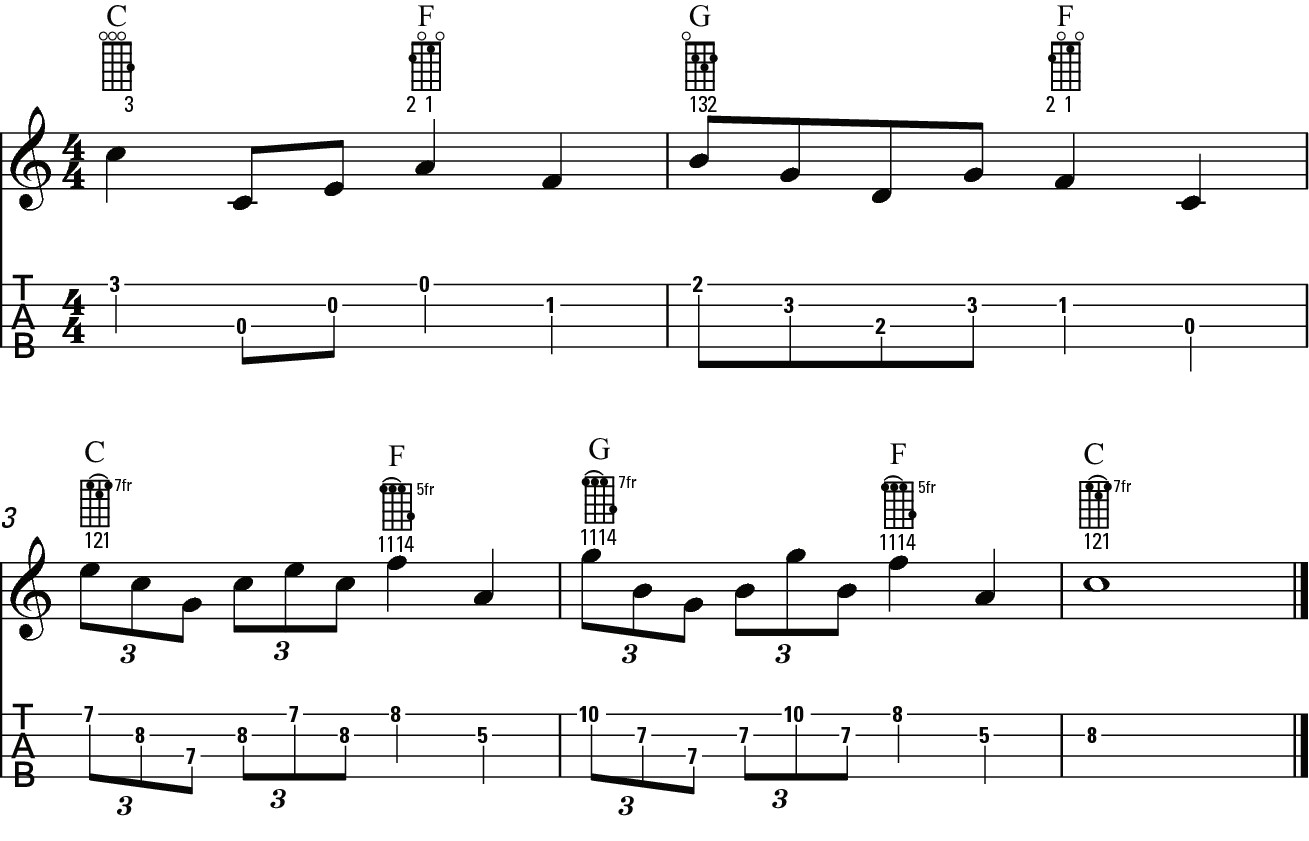Ukulele For Dummies (45 page)
Read Ukulele For Dummies Online
Authors: Alistair Wood

Using a pick
Despite the fact that in general I don't advise using a pick, sometimes doing so has its advantages. The harsh tone of a pick that makes it sound terrible for strumming can help your soloing cut through if you're playing with a group of ukuleles.
Find a very light pick and hold it gently between your thumb and the tips of your index and middle fingers.
Picks let you use a technique that can be very useful on the uke:
tremolo picking
. Here, you repeated pick the same note at a rapid tempo; this method allows you to play very long notes that otherwise would've stopped sounding. You can hear this technique often in the Ukulele Orchestra of Great Britain's arrangements.
 In tab, tremolo is shown with diagonal lines above the note, as in Figure 10-18. Listen to Track 45 for an example of tremolo picking.
In tab, tremolo is shown with diagonal lines above the note, as in Figure 10-18. Listen to Track 45 for an example of tremolo picking.
Figure 10-18:
Tremolo picking in tab.

Strum blocking
Strum blocking
is a way of playing single notes using strums by stopping all the other strings from ringing. For example, to play a note on the third fret of the C-string you have to mute the g-, E- and A-strings. You can do so by bringing your thumb over the top of the ukulele so that it rests on the g-string and muting the E- and A-strings with your fingers that aren't fretting.
 Strum blocking is by far the most difficult picking technique to master. You have to pay attention to the finger that's doing the fretting while using your other fingers to mute the remaining strings.
Strum blocking is by far the most difficult picking technique to master. You have to pay attention to the finger that's doing the fretting while using your other fingers to mute the remaining strings.
 The technique does, however, offer some big advantages. It makes switching between playing chords and soloing very easy and creates a forceful, rhythmic sound. I use the strum blocking technique to play Figure 10-19 in Track 46. Because strum blocking is a way of stopping unwanted notes it is not usually shown in tab, and is a technique you can use at your own discretion.
The technique does, however, offer some big advantages. It makes switching between playing chords and soloing very easy and creates a forceful, rhythmic sound. I use the strum blocking technique to play Figure 10-19 in Track 46. Because strum blocking is a way of stopping unwanted notes it is not usually shown in tab, and is a technique you can use at your own discretion.
Figure 10-19:
Playing the phrase with strum blocking.

Inventing Solos the Easy Way
During some extended soloing at a jazz gig, a friend said to me, âThat's not improvising, he's just making it up as he goes along.' Well, yes and no! Improvising is often thought of as soloing without any preconceived ideas, but that's not entirely correct. Improvising is really the practice of inventing solos â something that a player can also prepare in advance of a concert â but quickly and in the moment. When inventing solos (whether prepared or improvised), musicians call on all their knowledge of chords, scales and licks to navigate these aspects in new ways.
This section guides you through some ways to use chords and scales to create your own solos.
Soloing using chord shapes
The simplest way to create a solo is to play notes from the chord that's being played at the time. So you change the chord shapes as you do when you strum, but you pick out individual notes to build a solo.
 The better your knowledge of chord
The better your knowledge of chord
inversions
(playing the notes in a different configuration), the more effective this technique becomes. Figure 10-20 (Track 47) uses this technique over a CâFâGâFâC chord progression, the first time round using open chords and the second time round using other chord inversions.
Figure 10-20:
Solo using chord shapes.

Playing all the chord shapes
 As well as playing chord shapes, you can also solo by choosing and playing any of the notes from any of the chords in the sequence. So using a progression with C, F and G chords you can play a solo like that in Figure 10-21 (Track 48).
As well as playing chord shapes, you can also solo by choosing and playing any of the notes from any of the chords in the sequence. So using a progression with C, F and G chords you can play a solo like that in Figure 10-21 (Track 48).
Figure 10-21:
Solo using notes from all the chords in the progression.

 If you combine all the notes in the C, F and G chords, you get the C major scale.
If you combine all the notes in the C, F and G chords, you get the C major scale.
Soloing with scales
Most solos are constructed from scales: you simply select notes from a scale and build
licks
(short musical phrases or flourishes) or longer solos. The
pentatonic scale
is the easiest and most commonly used of all scales; it consists of five notes (hence the name) and comes in major and minor flavours.
